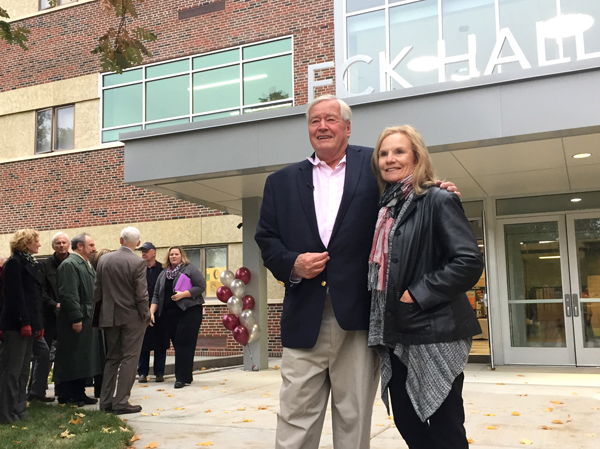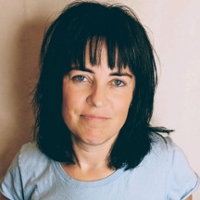- Editorial Offices
- 203 Brantly Hall
- Missoula, MT 59812
- (406) 243-2488
- themontanan@umontana.edu
Thinking Big With Buildings
Building dynamic spaces that are conducive to innovative learning.
In 2009, the Dennis and Phyllis Washington Foundation gave $14 million to the UM College of Education to transform the education building. It’s not just that the 27,000-square-foot addition expanded the space for the college’s five departments. It also made the building dynamic in a way that was inviting to students and conducive to innovative learning. It’s the type of space where you feel inspired just by being there.
“It’s a very flexible space,” says Adrea Lawrence, education college dean. “I see small groups of students working together. I see students doing robotic experiments for Science Methods, programming Lego robots and using them in the atrium during class to see how they might work with elementary-age children. The spaces are well-used inside and outside of class.”
This year, the college will celebrate yet another addition to the building, also funded with a $10 million gift from the Washington Foundation – along with a $5 million gift from the Alice Lee Lund Charitable Trust – to expand space for early childhood education, counselor education and the Montana Digital Academy, which offers online classes to rural schools across the state. Like the 2009 addition, the new one will include features conducive to the learning that prepares future educators.
Even in its construction phase, you could walk into the new addition from the old 1948 wing of the college and feel like you’d stepped through a magic doorway into the future. Three stories tall, it provides 35,000 square feet of collaborative space, with preschool classrooms designed to be flexible so student educators can reconfigure the room to experiment with multiple ways of teaching. There are observation rooms and ceiling microphones, so early childhood education students can learn from preschoolers as they naturally respond to social situations. Technology classrooms feature furniture on wheels to disrupt the traditional row-by-row classroom setup.
One of the most striking rooms is a two-story auditorium named in honor of UM alumna Alice Lee Lund, which seats nearly 600 people and can be used for conferences or a space for special events. Lund earned bachelor’s and master’s degrees from UM and was a passionate lifelong educator. Before her passing in 2001, she established a charitable trust and named the college one of its beneficiaries.
The architecture and flexible flow of the addition is breathtaking, but what happens inside is just as striking. The early childhood education program, which is a much-needed area of study, is a major focus.
“Montana is a one of a handful of states that doesn’t have public preschools,” Lawrence says. “And the benefits of a really robust preschool environment play out over the long term – over many decades – paying dividends in terms of benefits to society.”
Student teachers are instructed using cutting-edge research and techniques, and discover how to help children learn to solve problems in a variety of contexts. Because the college has a reputable clinical component, which places student teachers in classrooms across the state, what they learn at the college has immediate impacts on the greater community. Lawrence says the college hopes to fund an early childhood education director position to fortify the program.
Donors who supported the education college building and its technological features understand that modern and collaborative learning environments, endowed faculty, student scholarships and new programs are important. These are passionate people who fund aspects of the college that elevate it. One major supporter is Betsy Ross Wilcox, who along with husband A. Warren Wilcox, co-chaired the five-year quiet phase of Campaign Montana. She is committed to the well-being of children, and established the Intermountain Children’s Home Doctoral Fellowship to create a link between the college’s counselor education program and the nonprofit, which serves children in need of therapy.
“Expanding counselor education in the new addition will provide more room for curricular growth, training experiences and help to ensure the wellness of Montanans,” says Wilcox of her gift to the college. “It is through education and relationships that lives are changed, and we are grateful to be able to make a difference.”
UM alumnus and supporter Dennis Eck believes that liberal arts are the heart and soul of a UM education. With this in mind, he and his wife, Gretchen, gave more than $8.3 million to help the College of Humanities and Sciences overhaul the classroom wing of the Liberal Arts Building. They’ve renovated classrooms, installed advanced technology, upgraded infrastructure and given the building a grand entrance onto the Oval, among
other improvements.
“This modernization of the Liberal Arts Building, without tearing the building down, serves as a proof of concept for upgrading the University’s facilities without changing the campus’s characteristic beauty,” Dennis says. “Gretchen and I are proud to have our name associated with a project that will impact students every day and hope to inspire other donors and the state to support higher education.”

Story by: Erika Fredrickson
Erika Fredrickson is a freelance journalist based in Missoula. She graduated from UM’s Creative Writing Program in 1999 and earned a master’s degree in environmental studies in 2009.




